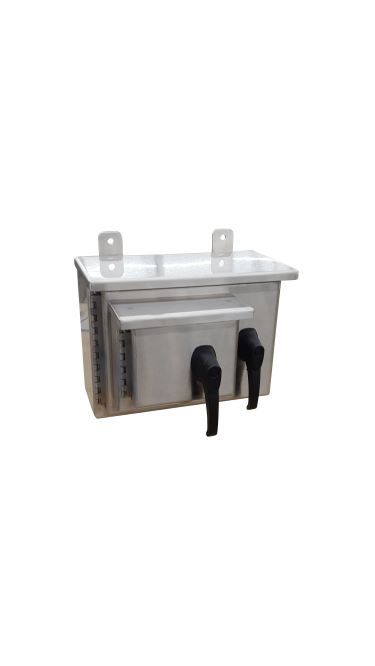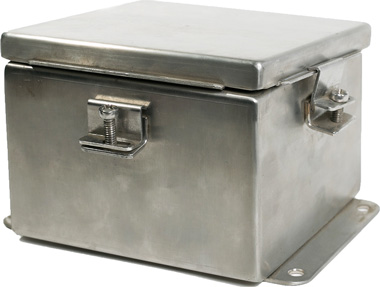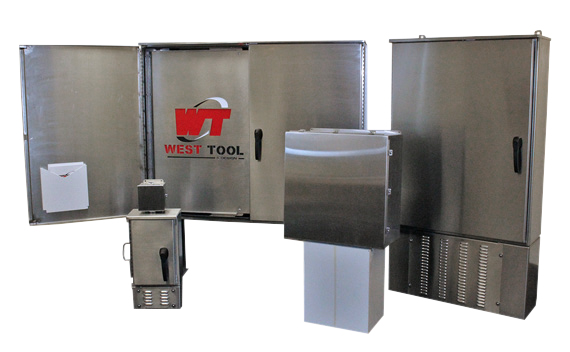< Return to FAQ
Stainless Steel Junction Boxes - Offering Corrosion Resistence

Owing to the critical part played by electrical junction boxes, it is vital to identify precisely what they can and cannot offer you. One of the pertinent queries about junction boxes, particularly stainless steel junction boxes, is whether they can provide corrosion resistance. West Tool Enclosures provides the best corrosion resistance junction
boxes on the market. With a vast catalog
of sizes and configurations to choose from.
Get Started
here!
So, do stainless steel junction box really offer corrosion resistance? In essence, yes, hence the wide application in the manufacture of both NEMA 6P and NEMA 4X, where corrosion resistance is significantly needed.
Typically, when it comes to protection against rain, wind, snow, and saltwater as well as corrosion, it all depends on the type of steel incorporated in the junction boxes. With electrical junction boxes, the stainless steel used is not just to enhance the overall aesthetic appeal, but to also further boost the boxes corrosion resistance properties. Since it is designed to attain finer finishes, the standard surface roughness subsequently decreases, therefore enhancing the metal’s overall corrosion resistance capacity.
Furthermore, besides the ultimate quality of the surface finish, the distinct grain orientation of conventional stainless steel enclosures usually has a massive effect on corrosion resistance. Generally, vertical grain orientation can aid in offering an easier as well as a more thorough cleaning because gravity-fed hose water and rainwater will subsequently run parallel to these grains. On the other hand, standard horizontal grain lines might consequently retain some corrosive contaminants, effectively accelerating the process of corrosion.
The distinct manner in which metals can corrode in any given setting is usually quite a challenge to predict. Why? The overall climate of one region may have a massive impact on the corrosion characteristics. Often, coastal regions can be significantly affected by some airborne salts transported over relatively long distances by strong winds. Because of this, special attention needs to be given not just to the overall climatic conditions of the area where the enclosures are installed, but also to the potential microclimates of the particular location of the enclosure. This scenario is especially evident in relatively cold regions where there is a regular occurrence of de-icing.

Typically, when it comes to industrial enclosures, the main priority is safeguarding the components and electronics inside. As such, the plan is placing the electrical enclosures in a region where they will not get wet at all, so long as the enclosures are regularly and thoroughly cleaned.
Covering the steel enclosures using a shield or alternatively positioning it under eaves will effectively prevent ice damage and water. Nevertheless, there is a disadvantage. When the enclosure is covered, it is unable to wash off subsequent contaminates that could lead to massive corrosion to the said stainless steel with time. Therefore, if you do decide to cover your enclosure, ensure that you regularly clean it.
Lack of ventilation, as well as higher humidity, is also another factor. This is why there is a need to refer to the standard NEMA ratings of the enclosure to guarantee that it offers the best possible protection against corrosion among other factors.
Advantages of Stainless Steel Electrical Enclosures

Superior Resistance to Chloride
Numerous regions across the country have corrosive salts. Besides coastal regions, the salt present in rainwater, as well as sea sprays, exposure to chloride is also a common occurrence in numerous parts across the nation which uses de-icing salts on the roadways. Usually, salt-laden roads, especially in colder climates, may at times develop even more substantial salt deposits compared to coastal regions. These de-icing salts get airborne through road mist and dust which enables them to travel long distances from some busy roads and subsequently deposit on the surrounding structures that include electrical enclosures, exterior furniture, and buildings, among others.
Corrosive Chemicals Resistance
Courtesy of molybdenum addition, the metal’s ability to resist sulfuric, sulfurous, and acetic acids, not to mention numerous industrial solvents and chemicals, is enhanced. Such corrosive process chemicals are often used in making diverse arrays of products such as textiles, inks, paper, photographic chemicals, rubber, as well as bleaches.
Superior Resistance to Pitting and Cracking
Depending on the type of stainless steel junction box used, it can provide enhanced creep resistance, minimized risk to stress corrosion, as well as increased protection against crevice corrosion and pitting.
Other Advantages
- Ideal for welding
- Excellent low-temperature performance
Selection Guide for Stainless Steel
As earlier mentioned, there are different types of stainless steel, and each offers a distinctly varied degree of protection. Nonetheless, the most common examples of stainless steel used in electrical boxes include:
(S30400) Stainless Steel 304
This type features low-carbon modification that boosts resistance to carbide precipitation, especially during the process of welding. It is commonly used in food and chemical processing equipment, cryogenic vessels, brewing equipment, downspouts, gutters, as well as flashings.
(S30403) Stainless Steel 304L
This type features extra-low-carbon modification that further restricts carbide precipitation, particularly during welding. It is used in tanks for tomato paste and liquid fertilizer as well as coal hopper linings.
(S31600) Stainless Steel 316
This stainless steel boasts higher resistance to corrosion compared to the 304 and 302 stainless steel as well as high creep strength. It is used in pulp and chemical handling equipment, brandy vats, photographic equipment, yeast tubs, fertilizer parts, as well as kettles used in ketchup cooking.
(S31603) Stainless Steel 316L
This type features extra-low-carbon modification of the 316 stainless steel type to suit welded construction application where it is necessary to avoid inter-granular carbide precipitation. Use of type 316 needs extensive welding.
(S32100) Stainless Steel 321
This type is stabilized especially for weldments that are subject to adverse corrosive conditions as well as for service precisely from 800º–1,600º F. It is used in boiler shells, aircraft exhaust manifolds, expansion joints, firewalls, process equipment, pressure vessels, and cabin heaters, not to forget flexible couplings.
NEMA Ratings
At West Tool Enclosures, our electrical enclosures are expertly designed following the relevant NEMA Quality Standards for Enclosures to ensure both reliability and product performance.
NEMA (National Electrical Manufacturers Association) has subsequently established a distinct NEMA 4X rating purposely for stainless steel (electrical) enclosures. This is to effectively address atmospheric corrosion effects. Typically, enclosures boasting the exclusive NEMA 4X rating adequately meet several minimum corrosion resistance conditions. In particular, the distinct material that is used in the construction of standard NEMA 4X-rated electrical enclosures MUST successfully withstand 200 hours of salt spray and exhibit minimal to no signs of corrosive pitting.
In fact, according to the NEMA standards, type 4X stainless steel enclosures are primarily designed either for outdoor or indoor use to offer a certain degree of protection to:
- The equipment within the enclosures against the entry of foreign (solid objects)
- Personnel against accessing hazardous parts
- Against any damaging effects on all the components housed within the enclosure due to water ingression
- Any corrosion
- Ice formation on the enclosures
West Tool Enclosures for Quality, Safety-Rated Stainless Steel Enclosures
In general, stainless steel junction boxes are able to protect all your sensitive equipment against corrosion even when the enclosures are fixed in areas with adverse weather conditions. West Tool Enclosures is the leading producer of corrosion-resistant stainless steel junction boxes.
At West Tool, we produce high-quality stainless steel electrical junction boxes all manufactured and consequently designed in compliance with the relevant NEMA standards. We build a wide array of NEMA 4X-rated stainless steel enclosures for marine, offshore, as well as corrosive condition applications.
West Tool fabricates quality NEMA-approved and UL-rated instrument and electrical enclosures to your precise specifications and which ideally meet your specified lead times. Here at WTE, we believe that catering to your unique electrical enclosure requirements will consequently save you frustration, time, as well as money.
Contact us today and get informed on the various corrosion-resistant stainless steel electrical enclosures available as well as how we can generate cost-efficient, quality electrical enclosures to safeguard both you and your equipment.